Many preppers spend lots of time fussing and fitting their bug-out bags, deciding on the perfect loadout, how they will pack it and, just as importantly, what kind and how big a pack they need for the purpose.
Even a cursory internet search will reveal dozens upon dozens, probably hundreds upon hundreds of articles on precisely that topic.

Your author here has written more than his fair share about it on this and other websites. It seems that load carriage is on just about every prepper’s mind, and that’s with good reason. You never know when you’ll need to grab your pack, and hit the road in a hurry.
But there is another element to load carriage that seems to me pretty neglected, and that is making use of alternate load-bearing gear for better efficiency, greater capacity and improved comfort.
Chest or belt mounted solutions can give you more places to store even more of your things, keeping items and equipment that you use on the regular close at hand, and helping you save your back and perhaps your hips from having to carry those few extra pounds.
In this article I’ll be discussing the advantages of supplementing your bug out bag or everyday carry kit with alternate load-bearing options, as well as the pros and cons of a variety of systems.
A BOB Alone May Not Be Ideal for all Circumstances
Don’t misunderstand me: I am all for having a bug out bag, and BOBs are a fundamental part of preparation, both for bugging out or just all-around preparedness.
You won’t ever go wrong having a packed BOB stuffed full of everything you’ll need to survive no matter the event, but it is not the full solution to the problem of load carriage.
A survival bag will certainly carry the lion’s share of the weight you are toting, but it concentrates all of that weight in one location on your body and is certainly not the easiest thing to access, especially when you need something quickly or you need to access something while you are on the move.
For anything but the smallest items that can be stowed in tiny pouches on your BOB’s shoulder straps or waist belt (if it has one), you will need to take off your pack in order to access the contents.
This takes time, wastes energy and is certainly aggravating when you just need that one, simple item to accomplish the task at hand.
If you have a very small pack, or one that is designed as a sling backpack, you can rotate it around to the front of your torso for a quick rummage, but packs of this nature are usually only optimized for small loads over short trips as a sort of daypack.
It almost sounds inconsequential: what’s the big deal about shucking your backpack to unzip a zipper and grab your beef jerky, compass or whatever it is that you need before donning your pack again? I get it.
And when you say it that way it sounds inconsequential indeed. But go on and do that five, ten or twenty times over the course of an extended movement by foot during the middle of a major emergency. That energy, aggravation and time add up.
There are also a few situations where a BOB is entirely inadequate, times that call for holding and storing your gear for rapid, immediate usage.
Certain items like firearms, knives and first-aid kits for immediate action or trauma response should not be buried inside your pack or even attached to the outside of it like some kind of nylon barnacle unless they are truly supplementary storage.
Anything you need right this second, and I mean right damn now, has to be on the front of your body, somewhere, where it can be accessed at a moment’s notice.
Luckily, any of the additional load-bearing options that we will be covering today are more than capable of keeping your emergency reaction gear and supplies close at hand and easy to access no matter the situation or your position!
Supplementary Load-Bearing Options
Like the old saying says, there is more than one way to skin a cat, so it is true that there are many ways to carry additional gear on your body, but not in or attached to your backpack.
That being said, some ways of skinning a cat work better than others, and you have probably already assumed that certain load-bearing methods are much more effective than others. You’d be right!
All of the methods I will be sharing with you today are ones you are likely already very well aware of, but it bears repeating that these methods work the best, for the most people, most of the time.
If you have, for some reason, discovered an alternate or entirely unique method to carrying your gear in a way that takes care of your own special circumstances, great.
Feel free to share, but don’t go around pooh-poohing tried-and-true methodology that will work for most people most of the time.
Without any more ado, let’s check out your options.
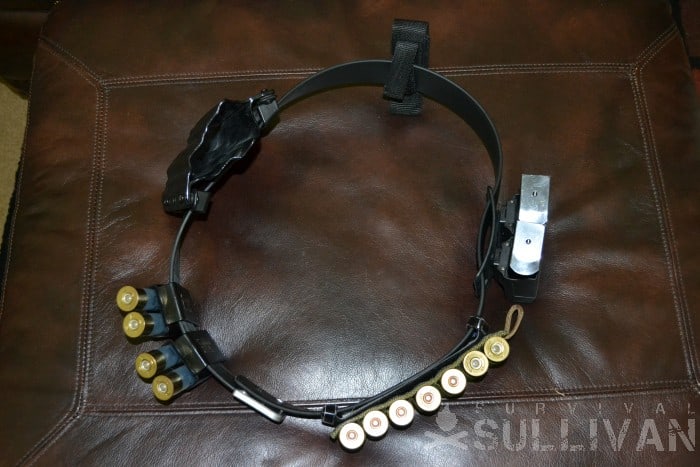
Gear Belt / War Belt
For any of you who grew up fascinated with the idea of the classic utility belt, a-la Batman and other superheroes, your dream might finally come true in the form of a gear belt for prepping.
Gear belts, sometimes called war belts if they are festooned predominately with a pistol and ammunition for that pistol or a long gun, are an excellent way to either add supplementary storage immediately with very little fussing, or to add pre-selected gear that you might need in case of emergency.
Any good gear belt setup will be extra wide, feature a quick-on-quick-off buckle and typically are made of extremely rigid woven nylon or some other synthetic material.
This provides stability and strength to the belt, and enables it to carry several additional pounds worth of gear.
Another great perk about a gear belt setup is that the entire kit and caboodle can be folded over on itself, and easily tucked inside a bag, perhaps even your BOB itself if you have room for it. Take a look:

This makes a gear belt a great option for space-conscious preppers.
Another advantage of a belt setup is it is very easy to access most things on the waist, so long as they are not otherwise hindered by an additional belt from your backpack.
Everything you place on the belt, at least on your frontal facing from 9 to 3 o’clock will be a cinch to access, and often with either hand. This is premium real estate for weapons, ammunition, radios, small tools, and any other goodies that you might need to use frequently or rapidly.
The disadvantages of gear belts are few, but you will need to be prepared to deal with them. First, unless you have a belt lightly loaded it may have a tendency to make your pants sag.
You can cure this in a couple of ways, the first being keepers which will attach your gear belt to your pants belt that goes through your belt loops. This is fairly fiddly and will take time.
Alternately you may use a set of lightweight padded suspenders to help hold the gear belt up.
Without suspenders, sagging may occur, but more importantly it could place additional stress on your hips if you have your belt heavily loaded.
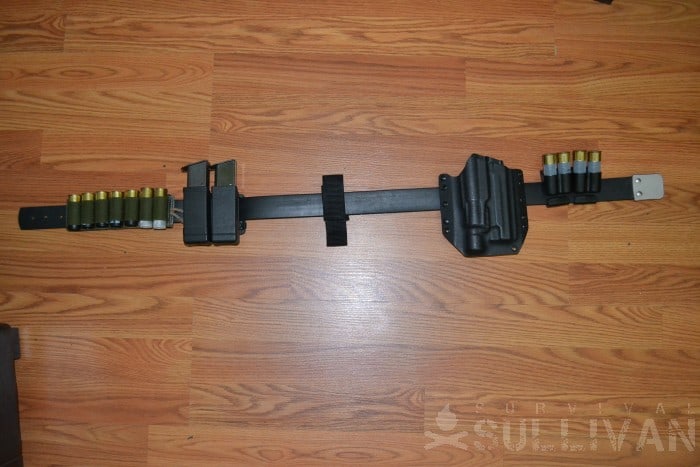
Gear belts support the placement of pouches or directly attached gear all the way around the circumference save the buckle area, but the rear facing of the belt might not be the best choice for placing your gear. It might even be wasted space depending on how low your backpack rides.
If your backpack rides on that section of your belt, you certainly won’t be able to access anything there easily, and it can also be pretty painful if your pack presses a pouch or piece of gear on the belt into your spine. Obviously, this won’t be a problem at all if you forgo the pack.
All in all, gear belts are a fine choice, being affordable and quickly donned supplementary load-bearing gear for your bug-out readiness kit.
Vest
The classic tactical vest was a staple of 1980’s and 1990’s era SWAT teams and action movies.
With the rise of hard body armor along with MOLLE/PALS webbing and modular pouches, the classic tactical vest covered with pockets, pouches and velcro has become obsolescent in most military and police circles.
Even though the sun is starting to set on the concept, it still has merit in certain circumstances where you do not require ballistic protection.
Tactical vests are available in all kinds of configurations, from universal arrangements that have nothing but utility pouches to more specialized types intended to hold specific magazines for a variety of firearms along with mission-specific gear.
Compared to something like a plate carrier, tactical vests are often significantly more affordable, much lighter and less cumbersome. If all you need is additional storage on your torso, a tactical vest can be a good option.
Certain vests are actually a halfway point between a plate carrier and a traditional tactical vest with a fixed assortment of pouches, being nothing more than a thin, mesh vest that is completely covered, front to back, with MOLLE or PALS webbing.
This means you can purchase and place exactly the pouches you need exactly where you need them, creating a customized tactical vest that is ideal for your needs.
Doing so is a little more expensive than buying an off-the-rack tactical vest, and also far more laborious to set up, or change for that matter, but this is an attractive option for those with specific needs.
Also, unlike the majority of armor packages available, it is possible to conceal a tactical vest under an outer garment like a jacket or even a looser fitting shirt. At least, it will conceal it to casual inspection assuming you don’t get too close to someone.
This might make the difference if you want to remain low profile or keep from “scaring the horses”.
Most tactical vests will not be foldable and stashable to the same degree that a gear belt will be, but they are much easier to store than a bulky, rigid plate carrier or soft armor carrier.
A tactical vest might also be just the ticket if you need additional storage beyond what a gear belt can provide, since the majority of them are completely covered with pouches that are entirely on the front of your body, meaning you won’t need to choose so often what items you’ll need to resign to your pack.
Many also have keepers and attachment points on the bottom hem specifically intended for attaching to either pants- or gear belts. This allows you to have the vest and the belt ready to go as a single unit.
You might get some ribbing from your gun-bro buddies for choosing an “outdated” vest over a plate carrier, but you’ll be the one who’s laughing while they are humping 20+ extra pounds of armor that they will probably never need.
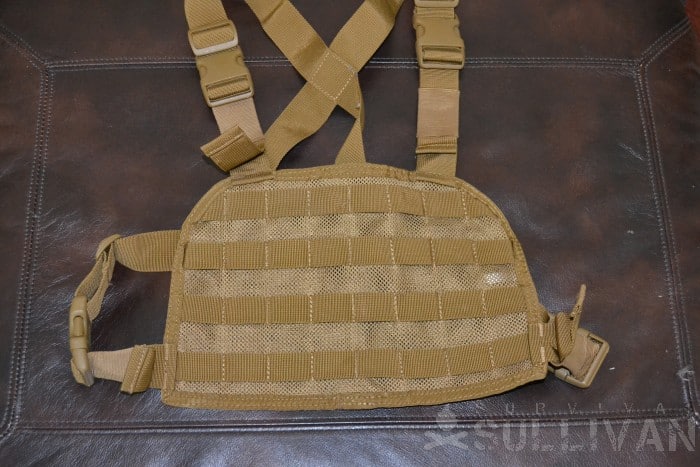
Chest Rig
Think of a chest rig as a minimalist vest, being a selection of fixed pouches or MOLLE/PALS webbing that sits only on the upper region of your thorax over the pectorals or sternum area.
The total storage capacity of a chest rig is actually comparable to a fully loaded gear belt and can similarly be folded up into a compact bundle when it is not being worn.
Chest rigs are ideal when you want body-mounted storage in a comparatively low profile format. Compared to something like a gear belt, chest rigs are great because they won’t make your pants sag and they don’t put any additional weight on your hips.
Most chest rigs use an H- or X-shape harness for support and stability, and this can put a little more wear and tear on your shoulders.
Most chest rigs are overtly military in nature, having magazine pouches, MOLLE/PALS webbing and other combat-centric features, but it is possible to get one that has a low-profile and civilian friendly appearance.
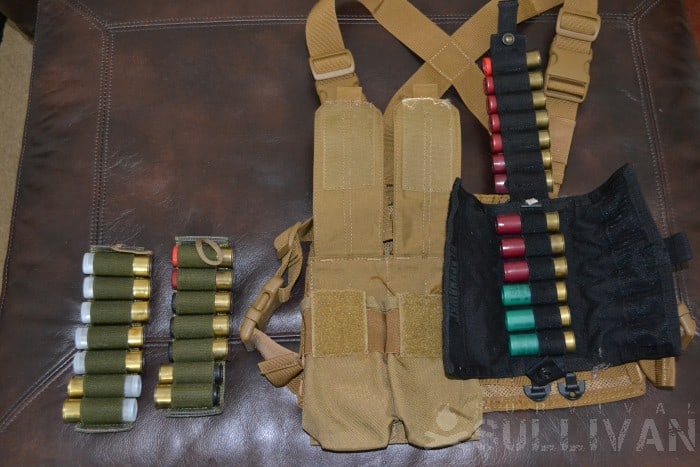
Chest rigs of this type are becoming increasingly popular with trail runners, hikers and various other outdoorsy types as replacements or supplements to their small day packs.
Certain chest rigs set up for the specific carry of concealed pistols can actually be ideal used in tandem with large packs, since the largest packs commonly interfere with the beltline area or utilize a belt of their own which might cover your holstered pistol.
Drawing a pistol from your chest area is actually a lot easier and faster than you might think, and, while not without its drawbacks, it can be the optimal solution for people who are going out heavy.
If all you need is a specialized solution for the carry of a pistol and a few magazines, or just want to keep the bare essentials that you need regularly close and handy, a chest rig is awesome!
Plate Carrier
The current must-have accessory for preppers and gun-centric personalities is a plate carrier complete with hard armor, typically ceramic.
These large and bulky carriers are overbuilt and strong enough to contain the substantial weight of hard armor plates (sometimes in conjunction with integrated soft armor).
These setups will provide varying amounts of ballistic protection depending on what type of strike face is inserted, and if the carrier itself provides any soft armor in conjunction.
Much like tactical vests plate carriers, as a rule, have built-in pouches or will more commonly be covered front and back with nothing but MOLLE/PALS wedding so that the user can add their own pouches depending on their mission profile or desires.
This flexibility has made this type of armor care system ubiquitous among military and many police forces.
The downside to these systems is universally their great weight. No matter what kind of hard armor you have you’re looking at quite a few extra pounds and that is before you add pouches carrying any other gear or ammunition, even when running the lightest UHMWPE plates.
A completely loaded plate carrier can easily weigh upwards of 20 lb. and that is before you add the weight of your backpack.
Nonetheless, the rigidity of a plate carrier with hard armor forms a stable, rigid “shell” of a mounting platform, and that means that it is possible to actually integrate your backpack with the rear facing of the carrier, providing you with an all-in-one solution if you so choose.
Speaking of that, aside from the weight, the other, not-so-obvious drawback is that a system so integrated means you cannot ditch one or the other in anything approximating a hurry.
If you need to take off your backpack, you’re taking off the plate carrier too, whole kit and caboodle. If your armor is busted and you just want to ditch the carrier, that means your pack comes off with it too.
A high quality plate carrier with properly made armor is a great piece of life insurance, but I would caution readers against buying one as a knee-jerk reaction just because everyone else is, and the “consensus of the web” seems to be that you are unprepared without it.
Not everybody needs ballistic protection that can defeat rifle rounds. You must always weigh that performance benefit against encumbrance and your energy budget, since you will never be able to go as far or as fast wearing armor as you would without it.
Possible Perks of Supplementary Load Bearing Gear
Adding the right load-bearing gear to your readiness setup can afford you some capability that you might not have otherwise. It is helpful to think outside the box and understand what the gear can do for you in terms of flexibility or options, not just extra storage.
Here are a few ideas to help get you started:
Emergency or Bailout Kit
You could use something lightweight and low profile (a chest rig or gear belt being perfect for this) as a minimalist backup survival kit to your BOB. It is a much easier thing to keep a chest rig or gear belt on at all times, say when you are bedded down at camp or operating a vehicle.
If something were to happen that forced you to ditch your pack, if you had a smaller but still full-featured, redundant survival kit contained in your chest rig or your belt, you wouldn’t be completely up the creek without a paddle.
Fighting Kit
Not everyone plans on going to war or even needs a full-blown fighting kit in the middle of a disaster or emergency. Some folks want to carry a single pistol and a reload if they carry even that much.
Nonetheless, a well-rounded prepper will be prepared for serious fighting in the case of something like widespread rioting, looting or other features of societal collapse and loss of rule of law.
You could keep a tactical vest, chest rig, gear belt or even, if you have the room for it, a plate carrier ready and completely decked out with additional medical supplies, ammunition and more for just such an occurrence.
It will be much easier to access weapons, ammunition and other tools off of one of these options versus rummaging and digging it out of your pack; trying to fight out of your BOB is a recipe for disaster.
Sustainment Load vs. Travel Kit
One of the oldest and most popular ways to segregate your kit by load-bearing type is to use a chest rig or vest for keeping all of your tools and gear that you need for traveling or movement problem-solving upfront and ready to access at any time, while keeping your heavier sustainment and living items in your BOB, since you’ll only be pulling them out when it is time to take a break or take shelter.
This will drastically minimize or even eliminate entirely the instances where you need to stop, take off your pack, dig into it, do what you need to do, and then repack it and redon it before setting off again.
Buddy Kit
You never know when a friend or family member in need will show up during a time of trouble.
It is entirely possible to use a compact piece of load-bearing gear, a belt or chest rig specifically, as a just-in-case item that is fully complemented and ready to hand off to a friend, complete with food, water storage, first-aid supplies and even ammunition.
This will obviously not be a concern for everyone, but if it is it is a small investment that you can make to ensure mutual survival for both you and your pal.
Conclusion
Supplementary load-bearing gear can afford you additional storage space beyond what your bug-out bag can provide alone, while also expanding your capability and flexibility when it comes to the use and carry of the gear you need to survive a SHTF situation.
Almost every prepper can benefit from a smartly chosen piece of load-bearing gear that will enhance their existing preparations.
Make sure to read over this list and research your options, and it won’t be any time before you find the perfect piece of kit.
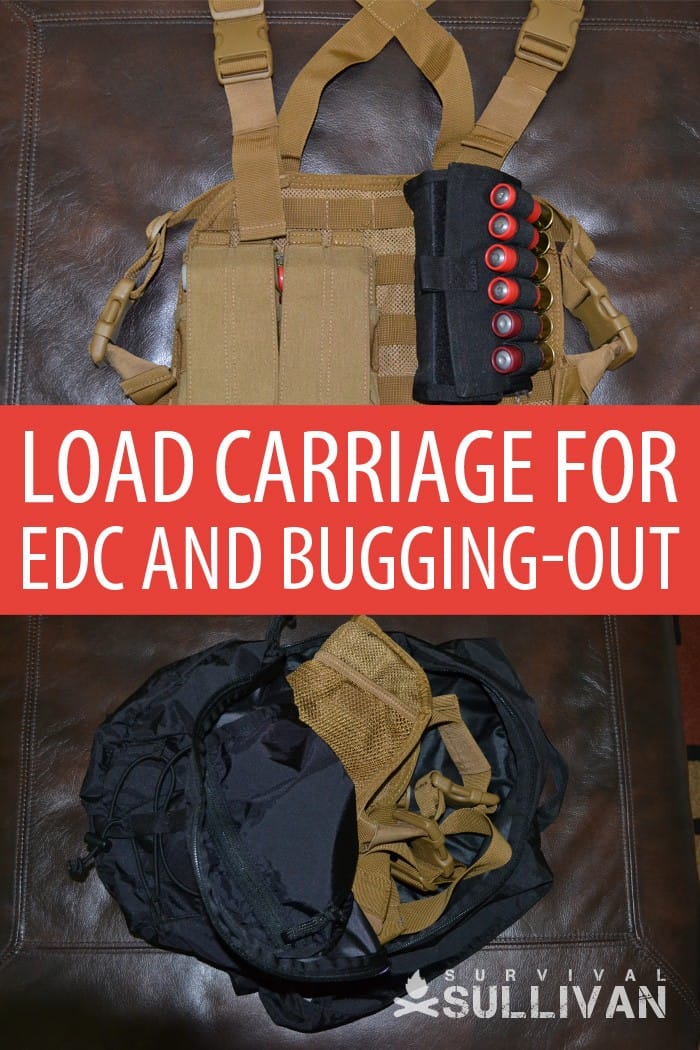
The post Load Carriage Options for EDC and Bugging-Out appeared first on Survival Sullivan.
